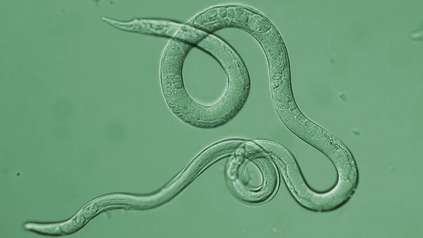First genetic map of one of humans oldest parasites
The largest genomic analysis of the whipworm Trichuris trichiura has been published, giving the most in-depth evolutionary insight about this human parasite to date.
This research, the result of an international collaboration that includes scientists from the Wellcome Sanger Institute, the University of Copenhagen, and many others*, gives a global set of genetic data to base new disease-fighting approaches on.
The study, published earlier this month (6 July 2022) in Nature Communications, provides the information needed to fill in some of the gaps in our current knowledge about the evolution and spread of this parasite. Using the genomic data to create a transmission map** and ongoing analysis of the worm’s genetic makeup can help track factors such as drug resistance, and predict how the parasite might continue to spread in the future, helping to inform public health decisions.
Trichuriasis is a neglected tropical disease that is estimated to affect as many as 500 million people worldwide1. This disease is caused by the whipworm, Trichuris trichiura, and is found most commonly in tropical and subtropical regions1. However, parasite eggs found in fossilised remains have shown that the whipworm once was globally distributed, with evidence of this seen in Europe and other sites in North America where infections are very rare.
Chronic parasite infections can cause a range of debilitating gastrointestinal issues, nutritional deficiencies, and delays in physical and cognitive development, especially in children. The majority of these cases are treated with one group of drugs, which have varying levels of effectiveness, and there are few alternative treatments available.
The research generated whole-genome DNA sequencing data of modern worms collected from both human and primate hosts. Such recent samples were obtained from multiple different regions including countries in Africa, Central America, Asia, and Europe.
These were compared to ancient samples obtained from archaeological dig sites, the oldest of these dating up to a thousand years old, primarily from Viking settlements in Denmark, as well as sites in the Netherlands and Lithuania. These samples are the oldest helminth samples from which whole-genome sequencing data has been generated, and are suggested to be the oldest eukaryotic pathogens, providing a unique insight into the parasites of humans’ past.
Comparison of genetic data from past and recent parasite from around the world showed how populations of geographically distributed parasites are related and the likely influence of human migration in the global spread of modern day parasites.
The researchers provide a global set of genetic data that could be used to inform strategies for managing parasites, with the broader aim to reduce the spread of disease. These data could also be used to help track parasite reaction to new and existing treatments, as resistance to current therapies is an obstacle of current drugs which may be increasing.
Through their analysis, the team provides further support that this worm is specific to humans, baboons and possibly other primates. Therefore, measures to try to stop the spread of T. trichiura will have to take this into consideration as only treating humans could be missing the worms found in other primates in certain regions.
“Trichuris trichiura was once found across the world, including in Viking times, but now it is mainly found in rural tropical and subtropical areas. Since early times, this soil-borne worm has been very effectively transmitted as majority infections are typically mild in healthy people. Our research has tracked the global spread of this parasite for the first time, giving a much more detailed evolutionary background of the whipworm to help researchers understand its journey through time, and help inform how it might spread in the future.”
Professor Christian Kapel, senior author and Professor of Organismal Biology at the University of Copenhagen, Denmark
“Trichuriasis can cause debilitating symptoms and have a huge impact on the development of children in the regions that it is prevalent in, which is why it’s crucial that we find new ways to prevent infections and treat this disease. One of the key takeaways from our research is that certain primates can also carry the disease-causing parasite, so it’s important to take this into consideration when planning measures to stop the spread of Trichuris trichiura.”
Dr Martin Jensen Søe, co-first author, previously at the University of Copenhagen, Denmark
“The human whipworm impacts millions of lives every year, and has been infecting humans for millennia. Before this study, there was a lack of genetic information about its evolution. Our research helps fill this gap by providing a global and extensive dataset that can be used to help track the spread and development of this disease-causing parasite. We hope these types of data could be used to help inform public health decisions in endemic areas in the future.”
Dr Stephen Doyle, co-first author, UKRI Future Leaders Fellow and Sanger Career Development Fellow at the Wellcome Sanger Institute
More information
*For a full list of collaborators, please see the publication.
**A transmission map is a geographical map with genetic data added. It can show where there are infections of the parasite in a certain area and if any of these parasitic worms have any specific genetic traits, such as drug resistance. This makes it possible to see how the parasite has spread through a region over time.
- Pullan, R. L., Smith, J. L., Jasrasaria, R. & Brooker, S. J. (2014) Global numbers of infection and disease burden of soil transmitted helminth infections in 2010. Vectors 7, 37.
Publication:
S. R. Doyle, M. Jensen Søe, P. Nejsum, et al. (2022) Population genomics of ancient and modern Trichuris trichiura. Nature Communications. DOI: https://doi.org/10.1038/s41467-022-31487-x
Funding:
This research was funded by the University of Copenhagen, a UKRI Future Leaders Fellowship, and Wellcome.



